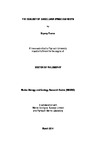The Ecology of Sabellaria spinulosa Reefs
| dc.contributor.supervisor | Hall-Spencer, Jason | |
| dc.contributor.author | Pearce, Bryony | |
| dc.contributor.other | School of Biological and Marine Sciences | en_US |
| dc.date.accessioned | 2017-10-26T10:07:08Z | |
| dc.date.available | 2017-10-26T10:07:08Z | |
| dc.date.issued | 2017 | |
| dc.date.issued | 2017 | |
| dc.identifier | 736123 | en_US |
| dc.identifier.uri | http://hdl.handle.net/10026.1/10098 | |
| dc.description.abstract |
Reef habitats built by the tubiculous polychaete Sabellaria spinulosa have been identified as a habitat with significant conservation importance, based on their historic decline across Europe and the assumption that, like many other biogenic reef systems, S. spinulosa reefs enhance biodiversity. Despite the high conservation status of this habitat very little work has been undertaken to explore the role that S. spinulosa reefs play in marine ecosystems, or their sensitivity to anthropogenic disturbance. Observations of the reproductive ecology and population dynamics of the reef building organism indicate that S. spinulosa exhibit life-history traits typically associated with r-strategists, indicating that this species is likely to have the ability to recover quickly following most anthropogenic disturbance events. A series of surveys on S. spinulosa reefs identified at the Thanet Offshore Wind Farm site, where the extent of the reef habitat was found to have increased between the pre-construction and post construction survey despite extensive cable laying and turbine installation, corroborates these findings. Detailed investigations into the macrofauna associated with S. spinulosa reefs in the eastern English Channel revealed that S. spinulosa reefs support macrofaunal communities that are comparable to those associated with adjacent muddy sandy gravel and gravelly muddy sand in terms of species composition, taxonomic breadth and beta-diversity. A consistent enhancement in species richness, abundance and biomass was identified in samples collected from S. spinulosa reefs when compared with adjacent sedimentary deposits, as well as a corresponding reduction in the equitability of species, indicating that some macrofauna are able to exist in higher densities within this habitat. The increase in macrofaunal biomass associated with S. spinulosa reefs was found to influence the diet of demersal fish species, with some species feeding on the reef organism itself while others feed on species found in high densities on the reefs. The high abundance of juvenile flatfish associated with this habitat also suggests that S. spinulosa reefs may provide an important nursery habitat. | en_US |
| dc.language.iso | en | |
| dc.publisher | University of Plymouth | |
| dc.rights | Attribution-ShareAlike 3.0 United States | * |
| dc.rights.uri | http://creativecommons.org/licenses/by-sa/3.0/us/ | * |
| dc.subject | Sabellaria spinulosa reef ecology | en_US |
| dc.subject | Ecosystem Services | en_US |
| dc.subject | Annex I Habitat | en_US |
| dc.subject | Sabellaria spinulosa reproduction | en_US |
| dc.subject | Offshore wind farm development | en_US |
| dc.subject | Marine food web | en_US |
| dc.subject.classification | PhD | en_US |
| dc.title | The Ecology of Sabellaria spinulosa Reefs | en_US |
| dc.type | Thesis | |
| plymouth.version | publishable | en_US |
| dc.identifier.doi | http://dx.doi.org/10.24382/442 | |
| dc.rights.embargoperiod | No embargo | en_US |
| dc.type.qualification | Doctorate | en_US |
| rioxxterms.version | NA | |
| plymouth.orcid.id | orcid.org/0000-0002-9719-1039 | en_US |
Files in this item
This item appears in the following Collection(s)
-
01 Research Theses Main Collection
Research Theses Main



